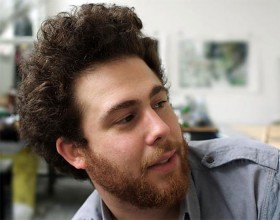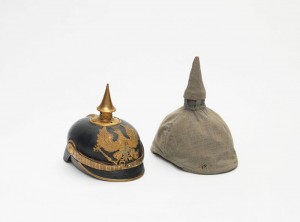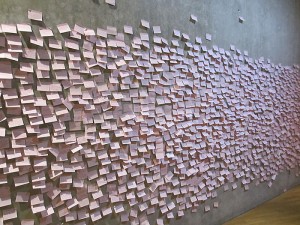
David Moses © photo: B.Gruhl
The construction and the fall of the Berlin Wall have occupied two generations of artists in the Moses family: in 1963/64 Manfred Heinz Moses created “The Balcony,” an etching on which, fifty years down the line, his grandson David Moses was to base a woodcut and polychrome etching. The latter works are likewise called “The Balcony” and they number among the unique pieces developed by seven artists resident in Berlin for the art vending machine on display in our permanent exhibition. A total stock of 1,400 artworks has been sold since early summer.
Grandpa Moses created his etching when still reeling from the shock of a trip to Berlin shortly after the Wall was built. It shows → continue reading
“Our inclination to hopefulness and expectations of a final victory are unabated and yet the long wait does at times begin to worry us.”
The cultural and literary historian Ludwig Geiger, son of the famous reformist rabbi Abraham Geiger, penned these lines to a friend on 5 December 1914. The “long wait” which had started to trouble him four months after the Great War broke out, ultimately dragged on for almost four more years and yet failed to bring the victory so yearned for. Soldiers at the time could barely imagine what massive destruction this first modern war would wreak. The paltry equipment with which they set off for the front is proof enough of that.

Dr Max Litthauer’s Pickelhaube (spiked helmet) with camouflage covering, 1914–1918. Donated by Bart Ullstein © Jewish Museum Berlin, photo: Jens Ziehe.
On display both in the exhibition “The First World War in Jewish Memory” at the Jewish Museum Berlin and in the special exhibition “1914–1918. The First World War” at the German Historical Museum (DHM) are Pickelhauben, spiked helmets made of hardened (boiled) leather and with a cloth covering for camouflage—for a metal spike protruding above a trench and catching the sunlight made its wearer a sitting target. On my guided tours of the two exhibitions, I take the Pickelhaube as an opportunity to talk about how much this war differed from previous ones as well as how ill-prepared the military was, initially, for the new weaponry deployed.
→ continue reading

A wall full of questions at the exhibition “The whole truth” © Jewish Museum Berlin, photo: Thomas Valentin Harb
The special exhibition entitled “The whole truth… everything you always wanted to know about Jews” ended more than a year ago. Besides the animated discussions and empty display cases, there are thousands of pink post-it notes left over. Visitors stuck their questions, commentary, and impressions on a concrete wall after they went through the exhibition and left the museum. A kind of analog “facebook” arose out of these contributions, above and beyond the contents of the exhibition itself. Visitors commented on each others’ notes and raised new questions: on the history of Jews in Germany, on the conflict in the Middle East, on the relationship between Christianity and Judaism, and – again and again – on the subject of circumcision. At this point, the Jewish Museum Berlin had already decided to dedicate not just another blog post to the contentious topic (as part of the series “Question of the month”), but an entire new exhibition.
We recall: → continue reading


